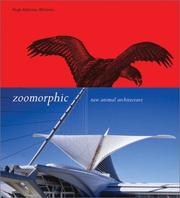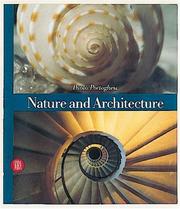| Listing 1 - 2 of 2 |
Sort by
|

ISBN: 1856693406 Year: 2003 Publisher: London Laurence King
Abstract | Keywords | Export | Availability | Bookmark
 Loading...
Loading...Choose an application
- Reference Manager
- EndNote
- RefWorks (Direct export to RefWorks)
Grammar --- Biology --- organic architecture --- drawing [image-making] --- Architecture --- morphology [attribute] --- Art --- Animalia [kingdom] --- Architecture, Modern --- Animals in art --- Decoration and ornament --- Animals --- Animaux dans l'art --- Décoration et ornement --- Animaux --- Exhibitions. --- Details --- Animal forms --- Exhibitions --- Symbolic aspects --- Expositions --- Détails --- Motifs animaux --- Aspect symbolique --- 72.012/013 --- Zoömorfe architectuur --- Organische architectuur --- Organisch bouwen --- Natuur --- Ingenieurswetenschappen ; zoömorfe architectuur ; in dier(en)vorm --- Draagconstructies --- Ruimtelijke constructies ; overspanningen ; kapconstructies --- Membrane architectuur ; tentstructuren --- 69.06 --- 72.013 --- organische architectuur --- architectuur 20e eeuw --- zoömorfe architectuur --- Architectuurontwerp --- Ontwerp (architectuur) --- Architectonisch ontwerp --- Bouwwezen ; draagconstructies, pneumatische constructies, overspanningen --- Architectuur ; proportie, symmetrie, harmonie --- architectuur - proporties, harmonie van afmetingen --- Décoration et ornement --- Détails

ISBN: 8881186586 9788881186587 Year: 2000 Publisher: Milano Skira
Abstract | Keywords | Export | Availability | Bookmark
 Loading...
Loading...Choose an application
- Reference Manager
- EndNote
- RefWorks (Direct export to RefWorks)
"Nature," wrote Novalis in a poem of Fragments, "is a magical city frozen in stone." This book, instead, considers architecture as the magical transcription of the shapes and laws of nature into the artificial universe of the city. Following on in the wake of modern art's urge to conjure up the primordial paths of expressionism, this book explores the natural origin of architectural archetypes: the column, the house, the wall, the door, the temple, the tower, etc. No matter the age or civilisation, all these elements are eternally present in the building activities of mankind. Evolving from research carried out in the sixties, this book not only examines the differences and similarities between natural and architectural forms, but it also draws comparisons between natural forms and the precepts and ideas that over the centuries have characterised the architecture of different cultures, not so much in order to highlight a manifest naturalistic inspiration but rather to comprehend the unity to which the human mind and the secret order of natural forms both belong. While acknowledging the central role of ecology, this book refers to the extraordinary achievements of science, especially the one that goes by the name of "new paradigm," to show architecture the way in which continuity and innovation can finally unite. An architecture which, fuelled by the spirit of a new alliance, becomes again the art of inhabiting the earth, putting aside its role as instrument and emblem of that thirst for dominion and violence enunciated by Bacon. A feminine architecture, far from the arrogance of the Babelic twilight years of the 20th century.
Architecture --- anno 1900-1999 --- Architectural design --- Nature (Aesthetics) --- Design architectural --- Nature (Esthétique) --- Philosophy --- Environmental aspects --- Philosophie --- Aspect de l'environnement --- Nature (esthétique) --- 72.012/013 --- 57 --- Zoömorfe architectuur --- Organische architectuur --- Organisch bouwen --- Natuur --- Architectuur en natuur --- Natuurvormen als inspiratie voor architecturale vormen --- Architectuurbeschouwing ; P. Portoghesi over natuur en architectuur --- 72.013 --- Proportie (architectuur) --- Ontwerp (architectuur) --- Architectuurontwerp --- Architectonisch ontwerp --- Biologie --- Architectuur ; proportie, symmetrie, harmonie --- Nature (Esthétique) --- natuur --- Architectuur --- Design architectural. --- Philosophie. --- Aspect environnemental. --- Nature (esthétique) --- Aspect environnemental
| Listing 1 - 2 of 2 |
Sort by
|

 Search
Search Feedback
Feedback About UniCat
About UniCat  Help
Help News
News